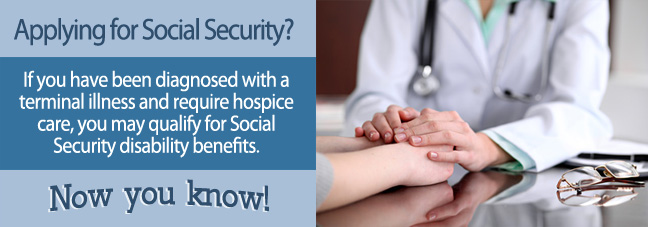If you or someone you love has been diagnosed with a terminal illness, your family’s financial situation should be the last thing on your mind. Fortunately, if you require hospice care you’re nearly guaranteed medical qualification for Social Security disability benefits.
There are many conditions that qualify for disability benefits. The Social Security Administration (SSA) approves millions of applicants for monthly benefits that can help pay for your hospice care, outstanding medical bills, your family’s housing or other expenses, and much more.
In most cases, anyone who has been diagnosed with a terminal disease should qualify for SSDI benefits if the terminal illness prevents them from going to work. In addition to these benefits there are other benefits available too such as auxiliary benefits.
Age and Social Security Disability Benefits
Most people receive Social Security disability benefits during their working years, and these disability benefits convert to retirement payments at age 65. Social Security disability is a separate program from Social Security retirement, and you cannot receive payments from both programs at once.
This means if you’re already receiving retirement benefits and you’ve been diagnosed with a catastrophic illness, you will not be able to apply for additional benefits due to a disability.
Medically Qualifying for Disability Benefits
To medically qualify for disability benefits, you’ll need to meet the SSA’s definition of disability: A condition that prevents an applicant from working for 12 months or more, or results in death. Anyone in hospice care will automatically meet the SSA’s definition of disability, unless you’re still maintaining employment.
The SSA will refer to its own medical guide of qualifying criteria, known as the Blue Book, when evaluating a claim. The Blue Book is the list of conditions that qualify for disability. There are hundreds of listed conditions that require hospice care. For example, someone with ALS will qualify with only a diagnosis that was established using “standard medical procedures,” such as reviewing EMGs, MRIs, and your medical history.
Applicants with any metastatic cancer (cancer that’s spread to other organs) will also medically qualify for disability benefits. The entire guideline for eligibility can be found online, so you can review the criteria with your doctor to determine if you’re eligible if you’re worried your claim will be denied.

What Does The SSA Mean By TERI Disability?
A disability is considered a TERI disability when it is expected to be terminal. Given the time sensitivity and additional emotional stress that is often found with a terminal illness, these are considered special cases in the eye of the SSA.
When applying for SSDIs with a terminal illness, you may be eligible for an expedited application process. In order to be considered a TERI case, a claims examiner or an SSA field office employee can alert the SSA that this claim should be handled differently.
For that to happen, a credible source needs to state that they believe the illness to be terminal. This can be a doctor, or someone close to the claimant like a friend or family member. Another way for a disability to be considered a TERI disability is if the claimant is on hospice.
Which Conditions Are Considered TERI Cases?
There is not one specific list of conditions that are considered TERI disabilities. Like other conditions, TERI cases still come down to your ability to prove your case with the evidence that you have provided. Some of the more common conditions that can qualify for as a TERI case are:
- Acute myelogenous leukemia (AML) or acute lymphocytic leukemia (ALL).
- ALS
- AIDS
- Cancer of the esophagus
- Cancer of the gallbladder
- Cancer of the liver
- Cancer of the pancreas
- Chronic dependence on a cardiopulmonary life-sustaining device.
- Heart Failure
- Mesothelioma
- Awaiting Organ Transplant such as heart, lung, liver, or bone marrow transplant
If you or a loved one is dealing with any terminal illness, disability benefits might help easy some of the financial burden.

SSDI TERI Waiting Period
There is typically about a five month waiting period for processing when a disability claim is submitted. But the Social Security Administration knows that some people don’t have that kind of time to wait. The SSA created a system that will flag TERI claims and expedite them so that they are processed quickly. Once a TERI claim has been processed and improved you can start receiving benefits quickly.
When you submit a TERI claim you will alert the SSA to the pressing need for fast processing when you first apply. The SSA’s computer system should flag all TERI claims but in case the system doesn’t work you should let them know you are submitting a TERI claim when you first apply.
The SSA can also be alerted to TERI cases by situations like:
- A family member, friend, partner, or the terminally ill person themselves letting the SSA know that the disability is caused by a terminal illness.
- The person submitting the claim is receiving inpatient end of life care or home hospice care or some kind of end of life care around the clock.
- The person submitting the claim has a letter of diagnosis of ALS or a letter of diagnosis indicating they have HIV/AIDS.
In any case where someone has a terminal illness and time matters it’s best to let the SSA know about the situation and not rely on their computer system to flag the application for expedited processing. That way there won’t be any delays in receiving benefits.
Survivors’ Benefits
If you pass away and leave dependent family members behind, they’ll be protected by Social Security disability benefits. The following family members are eligible for survivors’ benefits under your account:
- A child* under age 18, or under age 19 while still in high school
- A spouse over age 60
- A spouse with a disability over age 50
- A spouse of any age who’s caring for your child under age 16
Your survivors could be entitled to up to 75% of your monthly Social Security disability payments each. These benefits will continue until your children reach adulthood or if your spouse chooses to take Social Security retirement benefits under his or her own account.
Auxiliary benefits
Most people who are eligible to apply for Social Security Disability benefits because they have an illness or condition that is either terminal or prevents them from undertaking work related jobs believe they are the only ones eligible to receive disability benefits.
This isn’t entirely true, as in some cases the family of a disabled worker such as a spouse and dependent children may be eligible to receive benefits too. These benefits are called auxiliary benefits. Those that are eligible have to have a family member who is disabled and who is eligible to receive SSDI benefits.
The value of auxiliary benefits is related to how much tax the disabled family member has paid in the past. If you qualify, you will need to add the beneficiaries’ names when you start your claim for SSDI benefits.
If your spouse wishes to be included, s/he has to be below 62 years and has to be jointly caring for the children with you when you have lived together and the children have to be under 16 years of age.
If you have recently been involved in a divorce with your spouse your spouse might still be eligible for auxiliary benefits from your SSDI as long as you have been married for no less than ten years before your divorce. If your children would like to qualify for auxiliary benefits, they must be aged 18 years and be enrolled in school full time and can’t be married.

Can You get a Lump Sum from Disability If You Have a Terminal Illness?
If you have a terminal illness, you may be able to get a lump sum from disability in the form of back pay. Some terminal illness qualify for an expiated claim, which likely will may not qualify for back pay.
Back pay is a retroactive payment from the SSA covering months you should have been receiving disability benefits but were not. There is a 5-month waiting period when you apply for disability benefits, so the first 5 months you should have been receiving benefits will not be covered by back pay.
For example, let’s say you were diagnosed with a terminal illness in January and immediately applied for disability. If you were approved in November, 11 months after applying, you’d be eligible for 6 months of back pay (11 months – 5 month waiting period).
Many terminal illnesses fall under the SSA’s Compassionate Allowance Program, which allows for expedited claims. This means that your claim will be evaluated and approved a lot faster, which may allow the claim to be approved within the 5-month waiting period. Because your claim is expedited, you will be receiving your monthly benefits a lot quicker.
What are Retroactive Benefits?
Often there is a delay between applying and receiving SSDI benefit payments. Retroactive payments are made to SSDI applicants for the time that has passed between the onset of the disability to the date that the SSDI application was finally approved. Retroactive payments are paid for 12 months before the date that the application was passed.
Factors Considered for Retroactive Payments
There are three factors considered by the Social Security Administration before finalizing retroactive payments: These are:
- date of onset of disability;
- date of application
- wait period
All SSDI claims require a 5 month mandatory wait period following the onset of the disability. During this wait period nothing is paid. The retroactive payments are only made at the commencement of the sixth month.
An applicant for SSDI benefits is eligible for retroactive payments if:
- approval has been completed for the disability claim;
- over 5 months have passed since the EOD
- there is no reason to withhold payments.
The SSDI permits retroactive payments for 12 months maximum before the application date, while taking away the waiting period. That means typically that 17 months will have gone by since the onset date (EOD) and the date the application is approved.
Retroactive payments may only be made for 12 months maximum. This means that the applicant will not be paid before the considered 17 months are up. It may be possible to get back benefits dating to the commencement of the disabling condition.
Also, a victim may be due back benefits, dating back to the start of the disabling condition and a lump sum payment if approved.
Applying For Disability With Terminal Cancer
Unfortunately, cancer is a condition that affects many and has the potential to become terminal. If you will be applying for disability benefits with a terminal illness, here are some steps to take using terminal cancer as an example.
The most important part of any disability claim is the evidence that you will provide to the SSA. No matter the severity of your condition, you will not be able to qualify unless you are able to prove it. The first step is making sure that you are being treated by a doctor. Having a doctor on your side will be vital for your case because you will need to present objective medical evidence of your disability.
For terminal cancer, there are a few markers that might help your case be expedited. The first is metastatic cancer. This is cancer that has spread to other organs in the body. This might also be known as stage 4 cancer. Another piece of evidence that might demonstrate that cancer is terminal would be to show that it is persistent, recurrent, or inoperable.
Included in your claim will be hard medical evidence. Tests such as blood work or a biopsy can only be done by a doctor that has familiarity with cancer. A doctor can also provide testimony that your condition is likely terminal and therefore a candidate for an expedited application.

Expedited Treatment For Terminal Cancer
For terminal cancer, there are multiple programs that the SSA has that would allow you to receive expedited treatment. A candidate for TERI eligibility should make it clear in their claim that they expect the condition to be terminal. This is how it is flagged for the quicker application review.
However, you can also qualify for the Compassionate Allowances program. Similar to TERI this is a program meant to streamline the application process. Using technology, the SSA is able to quickly flag applicants that are very likely to meet the SSA Blue Book requirement because of severe conditions. This allows them to make decisions quickly for applicants where time is paramount.
Starting Your Application
The easiest way to apply for Social Security disability benefits is online from the comfort of your own home. If you’re unable to type for extended periods of time, you can ask a family member to fill out the application on your behalf.
Most people in hospice care qualify for expedited approval. There is nothing additional you’ll need to do when applying—your claim should simply be flagged for quick processing due to your disability. Most people in hospice care will be approved in as little as two weeks.